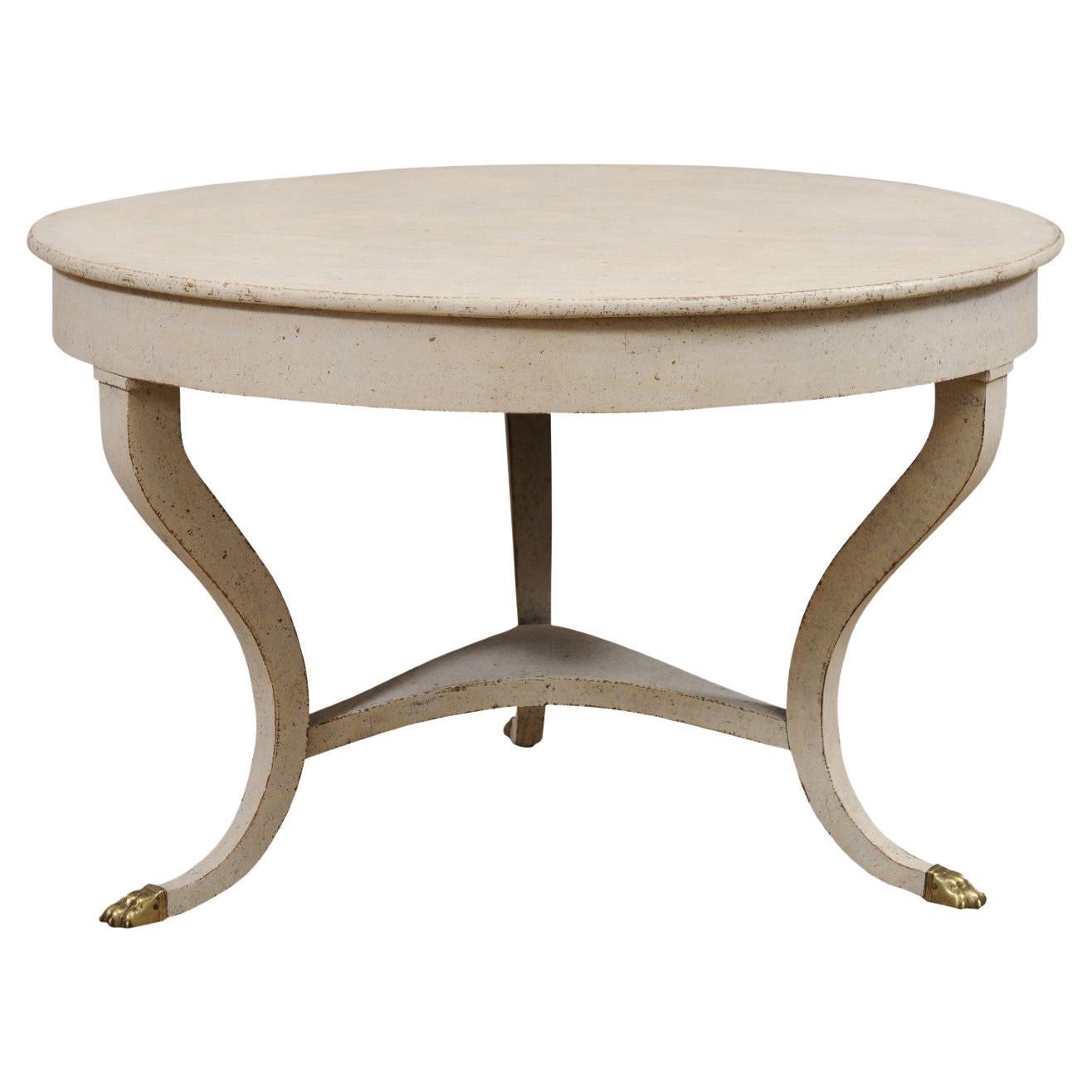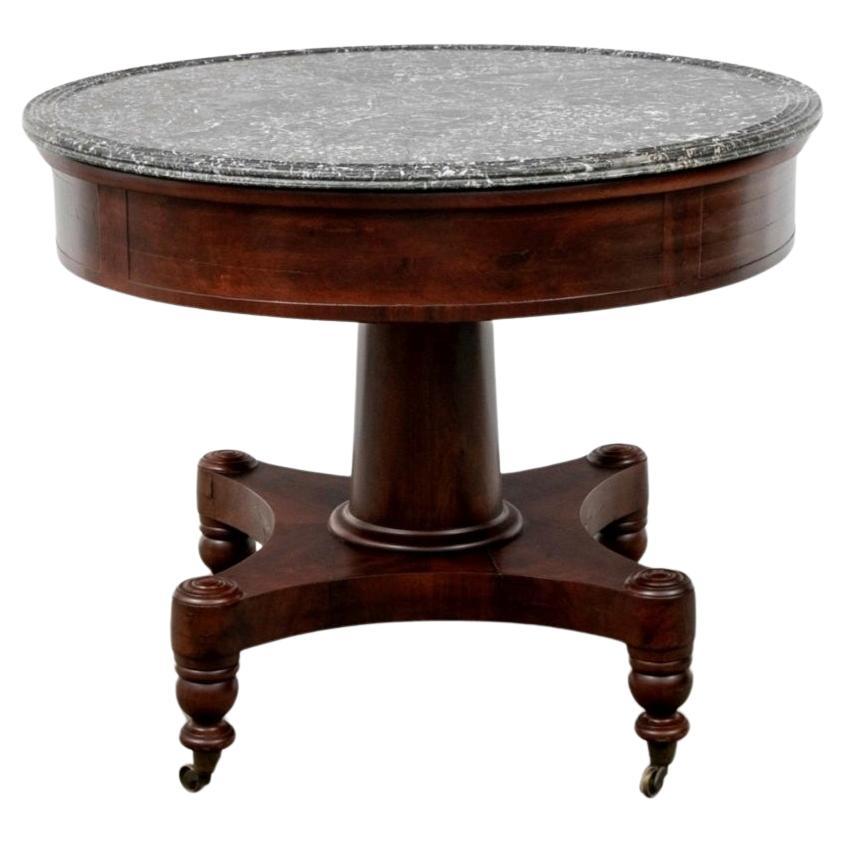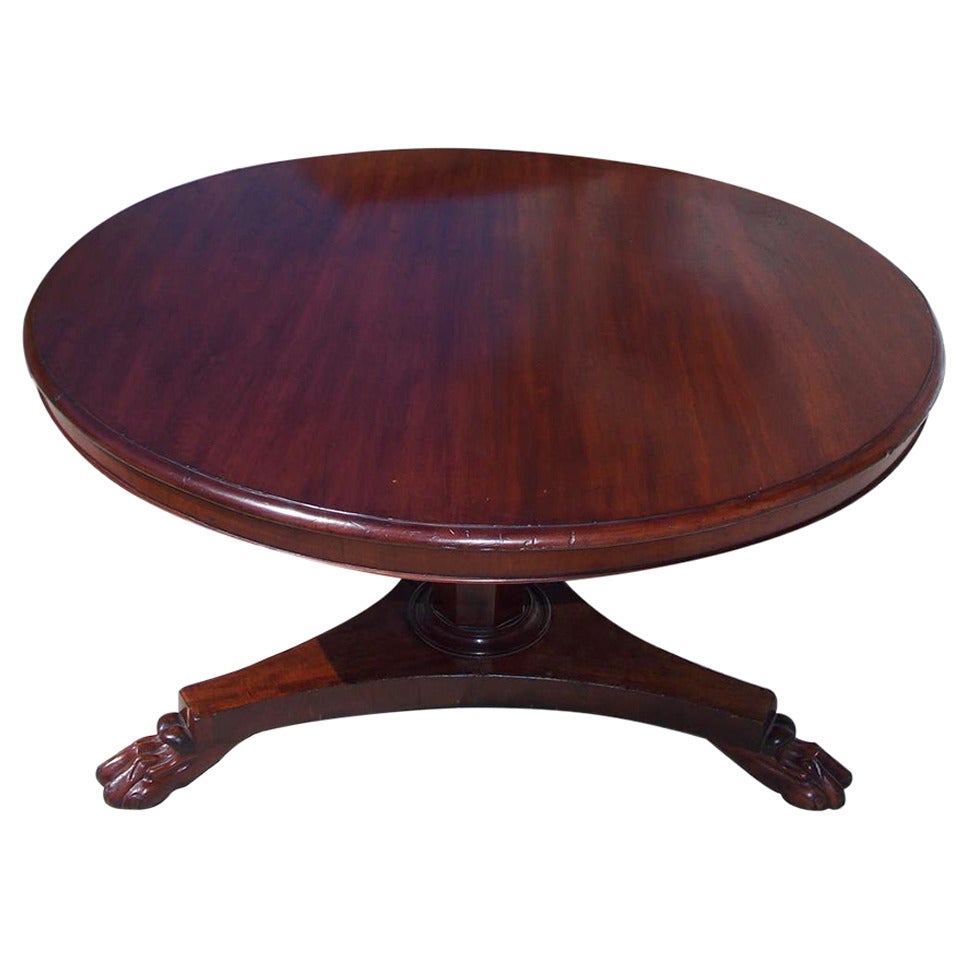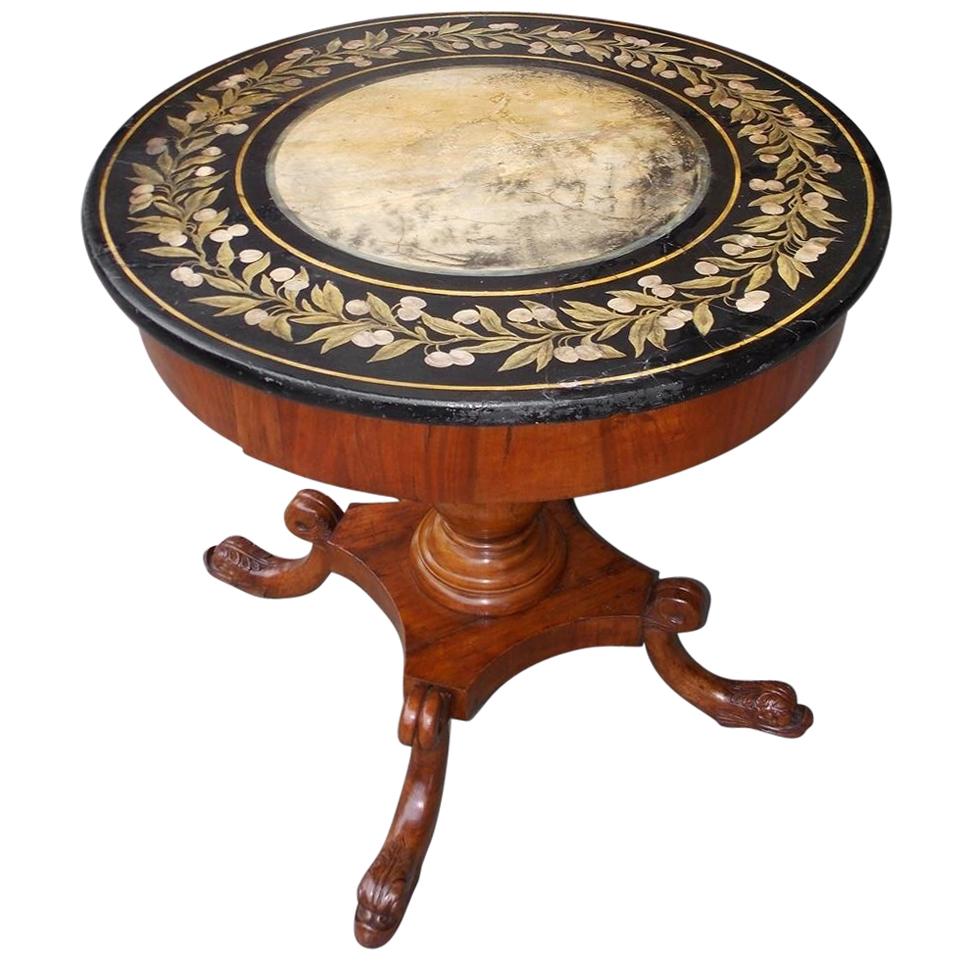Items Similar to Center Table with Scroll Legs, Paw Feet and Marble Tops
Want more images or videos?
Request additional images or videos from the seller
1 of 6
Center Table with Scroll Legs, Paw Feet and Marble Tops
About the Item
Center Table, about 1818–20
Attributed to Thomas Seymour (1771–1848), working either for James Barker or for Isaac Vose & Son, with Thomas Wightman (1759–1827) as carver, Boston
Mahogany (secondary woods: ash and white pine), with brass castors and green marble top
29 3/4 in. high, 36 in. diameter
RECORDED: Robert D. Mussey, Jr., and Clark Pearce, “Classical Excellence in Boston: The Furniture of Isaac Vose, 1789–1825,” in Boston Furniture 1700–1900, (Boston: The Colonial Society of Massachusetts, 2016), p. 271 fig. 31 illus., 272 // Robert D. Mussey, Jr., and Clark Pearce, Rather Elegant Than Showy: The Classical Furniture of Isaac Vose, exhib. cat. (Boston: Massachusetts Historical Society, in association with David R. Godine, 2018), pp. 128–29, 130 fig. 148
EXHIBITED: Hirschl & Adler Galleries, New York, 2018–19, Augmenting the Canon: Recent Acquisitions of American Neo-Classical Decorative Arts, no. 42 not illustrated
In the years after Thomas Seymour closed his own shop in 1817, he worked first for Thomas Barker in the years 1817–19, and then for Isaac Vose, from 1819 until the closure of the Vose shop in 1825.
In their recent study of Vose and the later work of Thomas Seymour, Robert D. Mussey, Jr., and Clark Pearce assigned both this center table and a matching pier table to the Barker/Seymour shop or the Vose/Seymour association in the years 1818–20.
A large silhouette by Augustin-Amant-Constan-Fidèle Edouart (1789–1861) shows Daniel P. Parker and his family in the parlor of their home at 40 Beacon Street, Boston (Mussey and Peace, Rather Elegant, p. 129 figs. 147A and B). In the curved niche at the left, reflecting the bay on the front of the house, is a table that is either the pier table referenced above (collection of Hirschl & Adler Galleries, FAPG 20975D/2; ibid., p. 131 fig. 149), or another of identical or similar design. Also shown by Edouart is a center table with three identical scroll legs that sit on a platform that itself appears to be lifted off the carpet by casters. That table has a horizontally reeded skirt in which is inserted a drawer that appears to be outfitted as a desk.
The present center table is identical in design to the Parker center table, although it lacks the reeding on the skirt, and the drawer.
Mussey and Pearce originally surmised that the Parker center table was possibly an English import—“the table is likely English, with its apron panels of thick reeding” (Classical Excellence, p. 271)—that served as the inspiration for the present center table and the companion pier table. But subsequently they wrote that “it could have been either imported or made in Boston” (Rather Elegant, p. 128), and based upon a whole group of furniture of related design, including a monumental side table made for Parker’s next-door neighbor, Nathan Appleton (collection of Historic New England, Boston; ibid., p. 107 fig. 119), there is little reason to look for its origin outside of Boston.
Mussey and Pearce also ponder the possibility that the present table may once have had a platform like that of the Parker table. But with its height of 29 3/4 inches, including its marble top, it would stand about 33 inches in height if it originally had a platform, and whereas 28 1/2–30 1/2 is the standard range of the height for center tables of this period, a height of about 33 inches falls substantially out of the norm. Further, a careful examination of the bottoms of the three legs reveals that they were originally hollowed out so that the casters were largely housed within the legs, adding only about 1/2-inch to the height of the table. (In their catalogue of the Vose exhibition, Mussey and Pearce erroneously give the height of the table as 36 inches [p. 130, fig 148]).
The present center table was supplied with a replacement marble top for its appearance in the Vose exhibition because it was judged at the time that the overhang of the marble top that had descended with it was too large. But an examination of the top that originally came with the table reveals substantial discoloration (“witness”) around the edge, which confirms that it was indeed the original top. It is likely not coincidental that the related pier table has a matching marble top, which also appears on the Appleton side table, signaling either a single commission, or a shop with a preference for a specific type of marble.
The carving on the table is by Thomas Wightman, who had a long association with Seymour, first when he ran his own shop, and later during his years with Barker and then Vose.
- Attributed to:Thomas Seymour (Cabinetmaker)
- Dimensions:Height: 29.75 in (75.57 cm)Diameter: 36 in (91.44 cm)
- Style:American Classical (Of the Period)
- Materials and Techniques:
- Place of Origin:
- Period:
- Date of Manufacture:about 1818-1820
- Condition:Refinished. Replacements made: Corner blocks are likely replacements. Wear consistent with age and use. CONDITION: Excellent. The mahogany surfaces have been cleaned and French polished. The corner blocks are likely replacements.
- Seller Location:New York, NY
- Reference Number:
About the Seller
No Reviews Yet
Recognized Seller
These prestigious sellers are industry leaders and represent the highest echelon for item quality and design.
Established in 1952
1stDibs seller since 2010
Typical response time: 1 to 2 days
Associations
Art Dealers Association of America
- ShippingRetrieving quote...Ships From: New York, NY
- Return PolicyThis item cannot be returned.
More From This SellerView All
- Pier Mirror with Églomisé PanelsLocated in New York, NYPier mirror with Reverse Painted, or Eglomisé, Panels, about 1800 New York, New York Eastern white pine, gessoed and gilded, with compo ornament, glass, reverse painted and gilded,...Category
Antique Early 1800s American American Classical Pier Mirrors and Console...
MaterialsGlass, Wood
- Plateau in the Restauration Taste with Grape and Leaf MotifsLocated in New York, NYFrench. Plateau in the Restauration taste with grape and leaf motifs, circa 1825. Ormolu and patinated bronze, with mirror plate and wood backing. Measures: 15 7/8 in. diameter, 3 11...Category
Antique 1820s French Neoclassical Platters and Serveware
MaterialsBronze
- Pair of Porcelain Urn Form Fruit Coolers with Covers and LinersBy Stône, Coquerel, and Legros d'AnisyLocated in New York, NYPair Footed Fruit Coolers, about 1810-20 Stône, Coquerel, and Legros D’Anisy, Paris (active 1808–49) Porcelain, partially transfer printed in sepia and green and gilded Each, 13 1/2 in. high x 10 in. wide x 7 1/2 in. deep Signed and inscribed (on underside of one top and one base, with printed mark): STÔNE / COQUEREL / ET / LE GROS / PARIS / PAR BREVET D’INVENTION: Manufre de Décors sur Porcelaine Faience; variously inscribed with decorators’ initial in green and brown (on underside of one top and one base): M; variously inscribed with incised mark (on underside of one liner and both bottoms): 3; inscribed (in blue script, on the inside of one liner): 615 The Parisian firm of Stône, Coquerel, and Legros d'Anisy is distinguished for the important role that it played in the introduction of transfer-printed decoration on fine china in France. Although the process had been known and used in Great Britain since the eighteenth century, it was, according to Régine de Plinval de Guillebon in her book, Porcelain of Paris 1770–1850 (New York: Walker and Company, 1972), not until 1802 that Potter, Blancheron, Constant, Neppel, Cadet de Vaux & Denuelle took out a patent in France for transfer-printing on earthenware, and it was only on February 26, 1808, that John Hurford Stône, his brother-in-law, Athanase Marie Martin Coquerel, and Francois Antoine Legros d'Anisy not only took out a patent for transfer-printing on china, but also established a Stône, Coquerel, and d'Anisy partnership for the manufacture of transfer-printed ceramics. Their address from 1808 until 1818 was at 9, rue de Cadran, Paris. Prior to this, Stône and Coquerel had been partners at a creamware factory in Creil, France, and Legros d’Anisy had worked at the Sèvres factory, where he had apparently developed the transfer-printing technique for which his own firm became well known. “The process,” notes de Guillebon, was “based upon removing from the engraving a ‘pull’ made on a specially coated filter-paper, which was pressed onto the object to be decorated; this object itself was covered with a film. Firing took...Category
Antique Early 19th Century French Neoclassical Wine Coolers
MaterialsPorcelain
- Pair of Armchairs En GondolesLocated in New York, NYFAPG 20555D/2 Pair "Fauteuils," or armchairs, en Gondoles, circa 1830-1835 New York Mahogany (secondary woods: ash) Each, 31 1/2 in. high, 21 1/8 in. wide, 21 1/8 in. deep (over...Category
Antique 1830s American American Classical Armchairs
MaterialsMahogany
- Pair of "Old Paris" Vases with Garlands of Bisquit FlowersLocated in New York, NYFrench, circa 1820. Porcelain, painted and gilded, with applied bisquit flowers 8 13/16 in. high. Inscribed (with incised mark, under the base of each): 3.Category
Antique 1820s French Neoclassical Porcelain
MaterialsPorcelain
- Butler's Desk and Etagére, New York, Possibly Duncan PhyfeBy Duncan PhyfeLocated in New York, NYButler’s Desk and Etagére, circa 1825 New York, possibly by Duncan Phyfe Mahogany (secondary woods: mahogany, pine, poplar), with ormolu mounts, marble,...Category
Antique 1820s American Neoclassical Cabinets
MaterialsMahogany
You May Also Like
- Danish 1810s Painted Hall Center Table with Curving Legs and Brass Lion Paw FeetLocated in Atlanta, GAA Danish painted hall center table from the early 19th century, with curving legs and brass lion paw feet. Created in Denmark during the first decade o...Category
Antique Early 19th Century Danish Center Tables
MaterialsBrass
- Antique American Boston Classical Mahogany Pedestal Center TableBy Thomas Seymour, Isaac Vose, John & Thomas SeymourLocated in Forney, TXA fine 200 year old American Federal period Boston Classical mahogany pedestal center table. circa 1825 Exquisitely hand-crafted in the Northeastern United States in the early 19th ...Category
Antique Early 19th Century American American Classical Center Tables
MaterialsMarble, Brass
- English Regency Mahogany Tilt-Top Center Table with Paw Feet, Circa 1815Located in Hollywood, SCEnglish Regency mahogany tilt-top circular center table with a carved molded edge, supported by a vase form bulbous ringed pedestal, original brass locking mechanism, and resting on ...Category
Antique 1810s English Regency Center Tables
MaterialsBrass
- English Mahogany Tilt Top Center Table with Lions Paw Feet, Circa 1820Located in Hollywood, SCEnglish mahogany tilt top center table with octagon shaped pedestal, tripod base, and resting on the original lion's paw feet with brass casters. Table has original brass locking mec...Category
Antique 1820s English George IV Center Tables
MaterialsBrass
- Marble Top Center TableLocated in Dallas, TXMarble top center table with applied bronze.Category
Vintage 1930s Unknown American Classical Center Tables
MaterialsBronze
- Italian Walnut Hand Painted Faux Marble Center Table with Dolphin Feet, C. 1815Located in Hollywood, SCItalian walnut one drawer hand painted floral and faux marble center table with a turned bulbous ringed urn pedestal, carved squared inset plinth, and terminating on four original ha...Category
Antique 1810s Italian Neoclassical Center Tables
MaterialsGesso, Walnut, Pine, Paint
Recently Viewed
View AllMore Ways To Browse
Three Leged Table
Three Leg Table
Antique Legs For Tables
Table With Brass Feet
Table Carved Feet
Antique Brass Table Legs
Table With Doors
Tops Antique
Antique Tops
Single Leg Tables
Curved Leg Table
Curved Table Legs
Antique Three Leg Table
Hands And Feet Table
Table With Curved Legs
Scroll Leg Table
Scrolled Leg Table
Wood Table Tops





